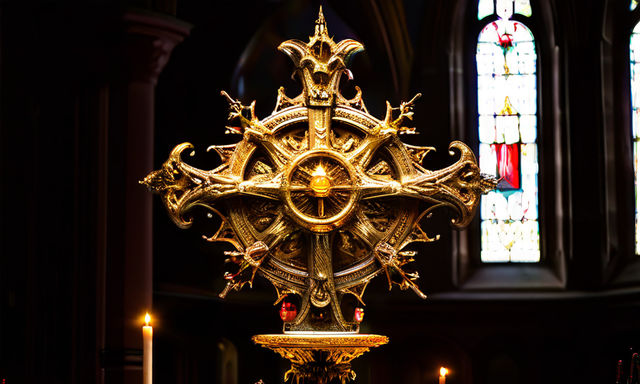
A Beacon of Faith: Unveiling the Church Monstrance
|
|
Time to read 4 min
|
|
Time to read 4 min
In the hushed reverence of a Catholic church, amidst flickering candles and intricate artwork, a special vessel often takes center stage: the Church Monstrance . More than just an ornate container, the monstrance holds profound theological significance and serves a specific purpose within the Catholic tradition. Let's delve into the world of the monstrance, exploring its history, design, symbolism, and the role it plays in the life of faith.
The first documented use of monstrances dates back to 14th century France and Germany. Coinciding with the rise of popular devotion to the Blessed Sacrament, the monstrance emerged as a way to publicly display the consecrated Eucharistic host. Early monstrances were modeled after reliquaries, vessels used to hold the remains of saints.
Over time, monstrances evolved into breathtaking works of art. Skilled metalworkers crafted them from precious metals like gold and silver, often adorned with intricate engravings, jewels, and symbolic imagery. The central feature is a lunette, a small circular holder made of gilded metal, which securely displays the consecrated host. The surrounding design often incorporates:
The size and complexity of a monstrance can vary greatly. Some are small and portable, used for private devotions or carrying the host to the sick. Others are majestic and monumental, designed to be the focal point during Eucharistic Adoration.
The Catholic belief in the Real Presence of Christ – the idea that the bread and wine become the body and blood of Christ during the consecration – forms the core significance of the monstrance. By displaying the consecrated host, the monstrance offers a physical representation of this profound mystery, allowing for a deeper encounter with the divine.
Eucharistic Adoration: This practice lies at the heart of the monstrance's use. The consecrated host is placed in the monstrance and exposed on the altar. Faithful gather for prayer and reflection, directing their devotion towards the Real Presence of Christ. This act of adoration fosters a sense of intimacy with God, allowing for silent communication and contemplation.
Solemnity and Veneration: The monstrance elevates the Eucharist to a position of honor and reverence. Its beauty and craftsmanship serve as a constant reminder of the sacredness of the sacrament. Processions with the monstrance, such as during Corpus Christi celebrations, publicly proclaim this belief and offer a visual expression of faith.
The use of the monstrance follows established guidelines within the Catholic Church. A consecrated host is carefully placed within the lunette by a priest or authorized minister. The monstrance is then positioned on the altar or a designated stand for veneration.
Preparation: Before placing the host in the monstrance, a priest ensures it's whole and free of any defects. A special veil or covering may be used to protect the host during transport.
Exposition and Reposition: The period during which the host is displayed in the monstrance is called exposition. This can be for a short time, like during a specific prayer service, or for a longer duration as part of a Eucharistic Adoration. Once the exposition concludes, the host is reverently returned to the tabernacle, a secure container on the altar where consecrated hosts are typically reserved.
Care and Maintenance: Monstrances, by their very nature, are precious objects. They require careful cleaning and polishing to maintain their beauty and ensure proper reverence for the Eucharist they hold. Depending on the material and complexity of the design, the cleaning process may involve gentle cloths, specialized solutions, and meticulous attention to detail.
The creation of a monstrance is a collaborative effort between skilled artisans. Here's a glimpse into the process:
The artistry involved in creating a monstrance can vary greatly. Some simpler monstrances may be crafted by a single skilled metalworker, while more elaborate pieces might involve a team of specialists – silversmiths, engravers, jewelers – working collaboratively under the guidance of a liturgical designer.
The time it takes to create a monstrance depends on its complexity. A simple design might be completed in a few weeks, while a masterpiece adorned with intricate details and precious materials could take months or even years to create.
While the monstrance holds a specific significance within the Catholic Church, other Christian traditions have vessels that share some similarities.
These parallels highlight the shared reverence for the Eucharist across certain Christian denominations, even if the form of display may differ.
The church monstrance serves as a powerful symbol within the Catholic tradition. It's more than just an ornate display piece; it's a window to the divine, a call to devotion, and a tangible representation of faith. The artistry and craftsmanship poured into its creation further elevate its significance, transforming it into a sacred vessel that inspires awe and reverence. As the Catholic faith continues to evolve, the monstrance remains a powerful symbol, reminding us of the centrality of the Eucharist and the enduring presence of Christ within the Church.